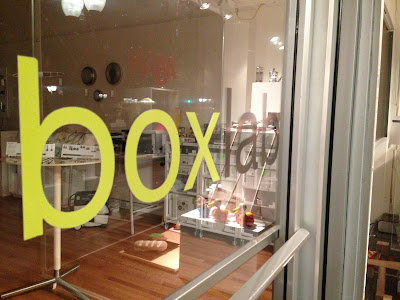The blessing (or curse) of being an academic is that
whenever I am talking to a small business, business association or local
government about their activities, I am always comparing their practices with
economic development theory. When I went to visit Christopher Spaw at Box Lab I was contemplating Adam Smith’s pin
factory and how businesses increase productivity. Smith’s basic thesis is that
the more stuff a community can make per person, the more prosperous the
community is and a community can accomplish this by specializing. Smith’s
famous example is the pin factory where, he says, one person can make one pin a
day if he is to do each of the steps himself. If 8 people work at it, each
focusing on a different step in making the pin (one person stretches the wire,
one person cuts the wire, another sharpens it, another adds the head, etc.)
they can make 1,000 pins a day. Specialization has increased to the degree that
it is not one person dedicated to stretching the wire but one company. Another
company cuts the wire and another assembles the pin. Within each of those
companies, people focus on even more specialized tasks.
And then I walk in to Box Lab. Box Lab is part architectural
office, part contractor, part landlord, part retail shop, part building
material dealer; in short, the opposite of specialization. Christopher says it
evolved this way because he wanted to demonstrate possibilities. As an
architect, his design aesthetic evolved in a European context. He designed
summer homes for Norwegian clients, drew inspiration from European cities. But
he is a K-State grad and wanted to bring innovative modern design and cutting
edge materials to Kansas. And not the bustling, metropolitan Kansas City but
two hours west, in little ol’ Manhattan.
Box Lab began as a specialist, a modern architectural
office. Christopher designed buildings that were modern and environmentally
responsible. Then the client would have to find someone to build the building
and find a supplier of the innovative and technologically advanced materials such
as the Quad-Lock insulated concrete
forms or the Alpen windows. In the
middle of Kansas, that can be difficult. But Christopher located here because
he believed that Kansans should have access to the same forward thinking design
that is available in Europe or big US cities. Box Lab began building the
buildings themselves and became a distributor for many of the materials used in
the building. Now the client can get the building they want and get it at a
lower cost than if they order each component separately.
Christopher said he wanted, “in a small-scale way to
showcase what can be done, what we are talking about.” He is not just talking about
a modern design aesthetic. He is talking about creating buildings that are
environmentally responsible, have lower utility bills, resist fire and natural
disasters. People come to Box Lab for many reasons. Opening the storefront on
Poyntz Avenue (the main business district in Manhattan) and expanding their
product lines is another way to reach people. They may come into the store for the
Luceplan light
fixtures or the Vola faucets. The store
captures their imagination about what is possible in their home. Sometimes it
leads to a remodeling project or addition. Other times it leads to ooh-ing and
ahh-ing over the jewelry by Susan
Richter-O’Connell.
How does a place like Box Lab fit into the quest for higher
productivity? They do not specialize in a product but they do specialize in an
idea. They demonstrate that my house does not have to be a sieve for warm air.
I can protect my home and family from disaster. Our house can be designed for
the ebb and flow of contemporary family life. Without the vision, without the
research in and access to pioneering design that Box Lab provides, I may never
know what is possible. “If you can show people other options, then they say,
‘yes, I get it.’” Christopher said.
When my family was in town last month, we visited Box Lab because my mother-in-law wanted to get some of the Haba toys for her (almost 9!) grandchildren. My parents, in the middle of a kitchen remodel were ogling the Miele appliances. Having downsized his tool collection, my brother-in-law was captivated by the Festool line of tools, and contemplated immediately rebuilding. My daughter, though 3, wanted to hold the Iittala glassware (and I followed her around repeating, “Look with your eyes, please.”) Box Lab began as an architectural office and became a curator of modern life.
